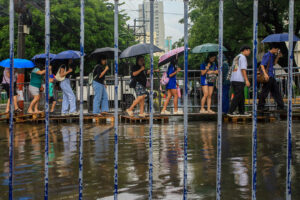By Patricia B. Mirasol, Multimedia Producer
APRIL B. ELISTERIA wades through knee-deep water every time it rains in her neighborhood in Las Piñas City. The 39-year-old helper at a private elderly care home and mother of four has lived with floods for as long as she can remember.
“Sometimes the floodwaters are thigh-high near the entrance of our community,” she said in an Oct. 8 Viber interview. “I walk a fair distance to the entrance because no car can enter our place anymore,” she added in Filipino.
Her family has elevated their home to keep floodwaters from seeping in. “We’ve been here for so long, we already got used to the situation,” Ms. Elisteria said. “When I get home, I take a shower right away to avoid getting sick.”
Floods remain a part of daily life for many urban poor Filipinos despite decades of government projects meant to address them. Now, those projects themselves are under scrutiny.
Government investigators recently confirmed that 421 of roughly 8,000 flood control projects nationwide were “ghosts” — nonexistent despite being allocated funds. The revelations triggered the removal of P255 billion ($4.4 billion) worth of projects from the proposed 2026 national budget, effectively cutting flood control allocations to zero.
As the scandal unfolds, public officials are looking to technology to restore trust, improve transparency, and curb corruption by design. Blockchain ledgers, livestreamed bidding and satellite mapping are now being tapped to track how every peso of public works spending moves — and whether something actually gets built.
The Department of Public Works and Highways (DPWH) has faced recurring questions over the integrity of its flood control program, a key infrastructure item in annual budgets. The “ghost” project revelations reinforced long-standing suspicions of systemic graft tied to infrastructure contracts.
Digitalization, automation and the removal of personal discretion create systems that make corruption more difficult, experts said.
The DPWH has begun livestreaming procurement activities, and on Sept. 30 launched “Integrity Chain,” a blockchain-powered transparency platform developed with the Blockchain Council of the Philippines (BCP).
The system aims to embed accountability into infrastructure workflows by maintaining immutable records that cannot be secretly altered.
The platform functions like a digital ledger, Mark S. Gorriceta, a founding BCP trustee, said in a Zoom interview. Every transaction, every data point is permanent once entered, and any tampering will be visible, he pointed out.
The Integrity Chain will initially cover foreign-assisted projects, which already follow stricter standards.
“Validation does not rely solely on the government,” Mr. Gorriceta said. “Independent validators from civil society, the academe, media, and nongovernment groups will check the data before it’s finalized.”
Public Works Secretary Vivencio “Vince” B. Dizon said during the platform signing that he welcomes private sector scrutiny. “Everyone should be watching,” he said.
Mr. Gorriceta said AI (artificial intelligence) would also be integrated to verify data accuracy. In three months, he expects the players to share the results from the pilot phase.
At least 10 blockchain-related bills are pending in Congress. But experts warn against seeing blockchain as a cure-all.
“Blockchain won’t prevent collusion among vendors and government officials,” Jeffrey Ian C. Dy, a former undersecretary at the Department of Information and Communications Technology, said in a Facebook post.
He also said the government’s lack of expertise could create dependence on proprietary systems “akin to graft.” Mr. Dy has suggested limiting blockchain to transactional data, defining clear rules on data use, and determining who should access it.
WATCHING FROM SPACEBeyond blockchain, agencies are turning to space-based monitoring to catch irregularities early. The Department of Human Settlements and Urban Development (DHSUD) is integrating satellite and geospatial data into its oversight systems.
Its Automated Land Use and Zoning Compliance Assessment and Monitoring (AutoCAM) tool uses remote sensing, machine learning and geographic information systems to track whether land use complies with local plans — and whether flood control projects are built in appropriate areas.
Ibani C. Padao, officer-in-charge director at the DHSUD’s Environmental, Land Use and Urban Planning and Development Bureau, said AutoCAM could detect zoning violations in real time.
“In protected agricultural zones, for example, if the tool detects that residential structures are being built, it will be tagged as not allowed or conditionally allowed,” he told BusinessWorld via Zoom.
DHSUD Assistant Secretary Mylene A. Rivera said the agency’s challenge lies in ensuring local governments use their approved land-use plans.
“After approval, these plans are often shelved and not used as a reference for development,” she said in the same Zoom call in Filipino. “Even diligent local governments learn about violations only after the fact because they don’t see everything.”
Ms. Rivera said AutoCAM could compare approved land-use maps with satellite images from the Philippine Space Agency (PhilSA). “If the plan doesn’t match what’s happening on the ground, the system flags it in real time,” she said. “That saves local governments a lot of time.”
The DHSUD will also launch a digital platform called PlanSmart for Sustainable Human Development on Nov. 17. It integrates hazard maps with planning data to help local governments make risk-informed decisions.
The initial rollout will cover 15 local governments per regional office, or about 200 nationwide. The target is for all local governments to have risk-informed plans by 2028. AutoCAM is slated for nationwide rollout by May 2026.
The Department of Budget and Management (DBM) has revived an older technology-driven project tracking system known as Digital Information for Monitoring and Evaluation, or DIME. First launched in 2017, it uses drones, geotagging, and satellite images to monitor major public investments. It was discontinued in 2021 and relaunched in 2023 through a partnership with the local space agency.
“The initial goal is to integrate PhilSA’s imagery with DBM’s platform,” Romer Kristi D. Aranas, information technology officer at the space agency’s High-Performance Computing and Information Systems Division, said via Zoom.
PhilSA expects project images to be publicly available through the DIME website by 2026.
“We are ready as far as technical capability and access to data are concerned,” Julius M. Judan, senior science research specialist at PhilSA’s Space Mission Control and Operations Division, said in the same Zoom interview.
He added that satellite data would be cross-validated with project timelines and milestones “to reach relevant conclusions.”
BEYOND THE TOOLSBoth Mr. Aranas and Mr. Judan stressed that government capacity-building is critical. “We integrate the data processing know-how and what the technical requirements are so it would be self-sustaining, and they can do it themselves long term,” Mr. Judan said.
Ms. Rivera of DHSUD said some local governments still lack the resources and expertise to use such tools effectively.
“You can’t give solutions if you don’t understand the situation on the ground,” she said in Filipino. “The goal is to make planning easy for them, to give them a template they can adapt to local realities.”
Experts say the technologies being deployed — blockchain, AI and satellite monitoring — mark progress toward transparency. Yet they emphasize that digital systems cannot replace political will.
Science and technology can provide tools that enable desired social outcomes, William G. Padolina, chairman of the Science, Technology and Innovation Foresight Steering Committee of the National Academy of Science and Technology, said in an e-mailed reply to questions.
“But the choice to harness which of these tools can promote societal interests, especially to recover from shocks, remains a political decision,” he added.
Mr. Dy said flood control corruption starts with budget enactment, which no technology could capture. “Perhaps the stance should shift from ‘anti-corruption’ to ‘increasing transparency in government.’”
Transparency advocates have long argued that corruption thrives in discretionary budgeting — a point made clear by the “ghost” projects’ discovery. Oversight mechanisms are often activated only after projects have been funded and payments released.
Economists note that eliminating P255 billion in questionable allocations could improve fiscal discipline in 2026, but warn of gaps in actual flood mitigation if legitimate projects are also delayed.
State efforts to digitize oversight represent a rare convergence of science, policy and accountability. Whether these systems will outlast political cycles — and actually prevent “ghost” projects — remains to be seen.
For residents like Ms. Elisteria, though, the test of reform will be simpler: the day her street finally stays dry. “I just hope the floods stop becoming a fixture in our lives because it’s so hard.”






